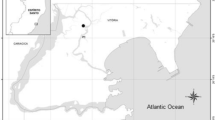Abstract
Uptake of lead (Pb) by submersed aquatic macrophytes and crayfish exposed to artificially contaminated pond sediment was measured under laboratory conditions. Macrophytes accumulated Pb in root tissue and foliage. Internal transport of Pb by plants was not detected. Senescent macrophytes accumulated more lead than live plants. Crayfish exposed to contaminated sediment accumulated Pb principally through adsorption to the exoskeleton and lost Pb through molting, although internal uptake and elimination without molting was measurable. Exposure to Pb leached from sediment, surface to weight ratios, and frequency of molting seem to influence Pb uptake by crayfish.
Similar content being viewed by others
References
Anderson, R. V.: The effects of lead on oxygen uptake in the crayfish,Orconectes virilis (Hagan). Bull. Environ. Contam. Toxicol.20, 394 (1978).
Anderson, R. V., and J. E. Brower: Patterns of trace metal accumulation in crayfish populations. Bull. Environ. Contam. Toxicol.20, 120 (1978).
Baier, R. W., and M. L. Healy: Partitioning, and transport of lead in Lake Washington. J. Environ. Qual.6, 291 (1977).
DeMarte, J. A., and R. T. Hartman: Studies on absorption of32P,59Fe, and45Ca by water-milfoil (Myriophyllum exalbescens Fernald). Ecology55, 188 (1974).
Dickson, G. W., L. A. Briese, and J. P. Giesy, Jr.: Tissue metal concentrations in two crayfish species cohabiting a Ten-nessee cave stream. Oecologia44, 8 (1979).
Franzin, W. G., and G. A. McFarlane: An analysis of the aquatic macrophyteMyriophyllum exalbescens as an indicator of metal contamination of aquatic ecosystems near a base metal smelter. Bull. Environ. Contam. Toxicol.24, 597 (1980).
Gale, N. L., E. Bolter, and B. G. Wixson: Investigation of Clearwater Lake as a potential sink for heavy metals from lead mining in southeast Missouri. In D. D. Hemphill (ed.): Trace substances in environmental health, Vol. X, p. 187. Columbia: University of Missouri. (1976).
Hutchinson, G. E.: A treatise on limnology. Vol. III. New York: John Wiley (1975).
Knowlton, M. F.: Transfer of lead and pentachlorophenol from aquatic sediments to aquatic vascular plants and crayfish. M. S. Thesis. University of Missouri-Columbia. (1981).
Mayes, R. A., A. W. McIntosh, and V. L. Anderson: Uptake of cadmium and lead by a rooted aquatic macrophyte (Elodea canadensis). Ecology28, 1176 (1977).
Odum, W. E., and J. E. Drifmeyer: Sorption of pollutants by plant detritus: A review. Environ. Health Perspect.27, 133 (1978).
Sanders, H. O.: Sublethal effects of toxaphene on daphnids, scuds, and midge. EPA 600/3-80-006 (1980).
Sauter, S., K. S. Buxton, K. J. Macek, and S. R. Petrocelli: Effects of exposure to heavy metals on selected freshwater fish. EPA-600/3-76-105 (1976).
Sharpe, V., and P. Denny: Electron microscope studies on the absorption and localization of lead in the leaf tissue ofPotamogeton pectinatus L. J. Exp. Bot.27, 1155 (1976).
Stein, R. H., and M. L. Murphy: Changes in proximate composition of crayfishOrconectes propinquus with size, sex, and life stage. J. Fish. Res. Board Can.33, 2450 (1976).
Welsh, R. P., and P. Denny: Water plants and the recycling of heavy metals in an English lake. In D. D. Hemphill (ed.): Trace substances in environmental health, Vol. X. p. 217. Columbia: University of Missouri (1976).
—: Translocation of lead and copper in two submerged aquatic angiosperm species. J. Exp. Bot. 30, 339 (1979).
Author information
Authors and Affiliations
Rights and permissions
About this article
Cite this article
Knowlton, M.F., Boyle, T.P. & Jones, J.R. Uptake of lead from aquatic sediment by submersed macrophytes and crayfish. Arch. Environ. Contam. Toxicol. 12, 535–541 (1983). https://doi.org/10.1007/BF01056549
Received:
Revised:
Issue Date:
DOI: https://doi.org/10.1007/BF01056549




